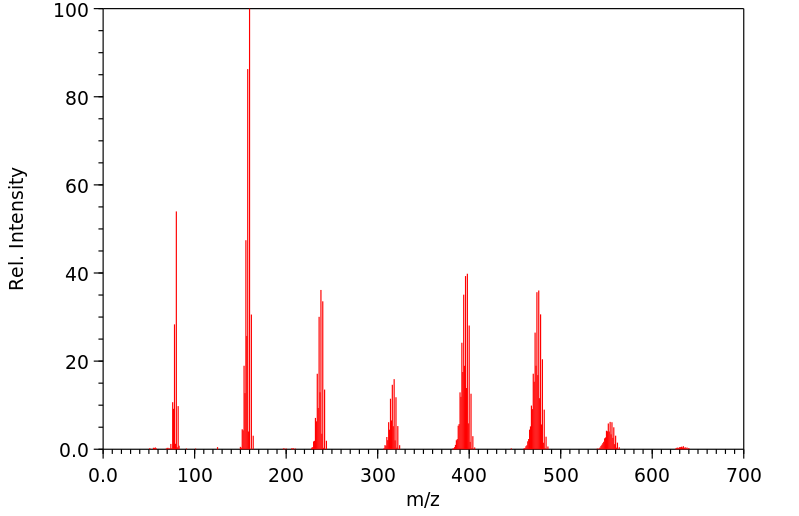环八硒 | 12597-33-0
分子结构分类
中文名称
环八硒
中文别名
——
英文名称
selenium
英文别名
Cyclooctaselenium;octaselenocane
CAS
12597-33-0
化学式
Se8
mdl
——
分子量
631.68
InChiKey
JWMKWLJGSKAGLH-UHFFFAOYSA-N
BEILSTEIN
——
EINECS
——
-
物化性质
-
计算性质
-
ADMET
-
安全信息
-
SDS
-
制备方法与用途
-
上下游信息
-
文献信息
-
表征谱图
-
同类化合物
-
相关功能分类
-
相关结构分类
计算性质
-
辛醇/水分配系数(LogP):-3.05
-
重原子数:8
-
可旋转键数:0
-
环数:1.0
-
sp3杂化的碳原子比例:0.0
-
拓扑面积:0
-
氢给体数:0
-
氢受体数:0
SDS
上下游信息
-
下游产品
中文名称 英文名称 CAS号 化学式 分子量 —— selenium 12597-30-7 Se6 473.76
反应信息
-
作为反应物:参考文献:名称:Gmelin Handbuch der Anorganischen Chemie, Gmelin Handbook: Se: SVol.A2, 10, page 78 - 84摘要:DOI:
-
作为产物:参考文献:名称:铜催化(杂)芳胺的Sandmeyer型三氟甲基硫醇化和三氟甲基硒化摘要:在催化量的硫氰酸铜存在下,分别与Me 4 NSCF 3或Me 4 NSeCF 3反应,可以将芳族和杂芳族重氮盐有效地转化为相应的三氟甲硫基或硒醚。这些Sandmeyer型反应在室温下在一小时内即可进行,适用于多种功能化分子,并可选择性地与重氮化反应合并为一锅法操作。DOI:10.1002/chem.201503524
-
作为试剂:参考文献:名称:Synthesis of 1-Benzometalloles Containing Group 14, 15, and 16 Heavier Elements via a Common Dilithiostyrene Intermediate.摘要:第14族(Si、Ge、Sn)、第15族(P、As、Sb、Bi)和第16族(Se、Te)的2-三甲基硅基-1-苯基金属富烯(7)是通过相应的金属试剂与β,o-二锂-β-三甲基硅基苯乙烯中间体(6)反应制备得到的,该中间体(6)是通过苯乙炔或邻溴碘苯经过三步反应衍生而来。7中的三甲基硅基可以通过四丁基氟化铵处理方便地去除,得到C未取代的1-苯基金属富烯(10)。DOI:10.1248/cpb.42.1437
文献信息
-
Thioacyl complexes of molybdenum and tungsten作者:Darren J. Cook、Anthony F. HillDOI:10.1039/a701270e日期:——The reactions of a range of alkylidyne complexes of molybdenum and tungsten [M(CR)L n ] with 2-methylthiirane provide the first thioacyl complexes [M(η 2 -SCR)L n ] of these elements, which serve as precursors for complexes bearing dithiocarboxylate, thioselenocarboxylate, thiolatocarbene and α-thioalkyl ligands and thioacyl-bridged binuclear complexes.
-
Syntheses and Reactivity of the Diselenido Molybdenum−Manganese Complex CpMoMn(CO)<sub>5</sub>(μ-Se<sub>2</sub>)作者:Richard D. Adams、O-Sung KwonDOI:10.1021/ic030077z日期:2003.10.1by insertion of ethylene into the Se-Se bond. Compound 2 also reacted with (PPh(3))(2)Pt(PhC(2)Ph) and CpCo(CO)(2) to yield the complexes CpMoMnPt(PPh(3))(2)(CO)(5)(mu(3)-Se)(2), 5, and Cp(2)CoMoMn(CO)(5)(mu(3)-Se)(2), 6, respectively, by insertion of the metal groupings CpCo and Pt(PPh(3))(2) into the Se-Se bond of 2. The oxo compound Cp(2)CoMo(O)Mn(CO)(5)(mu(3)-Se)(2), 7, was obtained from 6 byCpMoMn(CO)(8)与元素硒和Me(3)NO在不存在光的情况下反应,生成二硒烯基络合物CpMoMn(CO)(5)(mu-Se(2)),2。化合物2带有桥连垂直于Mo-Mn键的二硒代配体,Mo-Mn = 2.8421(10)A.在室内光线下,反应生成四核金属配合物Cp(2)Mo(2)Mn(2)(CO) (7)(mu(3)-Se)(4),3(36%产率)和2(7%产率)。通过将乙烯插入Se-Se键中,化合物2与乙烯反应生成乙二烯络合物CpMoMn(CO)(5)(mu-SeCH(2)CH(2)Se),4。化合物2也与(PPh(3))(2)Pt(PhC(2)Ph)和CpCo(CO)(2)反应生成复合物CpMoMnPt(PPh(3))(2)(CO)(5) (mu(3)-Se)(2),5和Cp(2)CoMoMn(CO)(5)(mu(3)-Se)(2),6通过插入金属基团CpCo和将Pt(PPh(
-
Formation of (η-Cyclopentadienyl)(1,2-ethylenedithiolato, 1,2-ethylenediselenolato, and 2-selenolatoethylenethiolato-<i>S</i>,<i>Se</i>)cobalt(III) Complexes in a One-Pot-Reaction of (η-Cyclopentadienyl)(1,5-cyclooctadiene or dicarbonyl)cobalt(I) with Alkyne and a Mixture of S<sub>8</sub>and Se<sub>8</sub>作者:Masatsugu Kajitani、Ryuji Ochiai、Kakushi Dohki、Norikazu Kobayashi、Takeo Akiyama、Akira SugimoriDOI:10.1246/bcsj.62.3266日期:1989.10of (η-cyclopentadienyl)(1,5-cyclooctadiene or dicarbonyl)cobalt(I) with alkyne (diphenylacetylene and phenylacetylene) and a mixture of S8 and Se8 gives (η-cyclopentadienyl)(2-selenolatoethylenethiolato-S,Se)cobalt(III) complex in addition to the corresponding dithiolato and diselenolato complexes. When phenylacetylene was used as an alkyne, a (2-phenyl-2-selenolatoethylenethiolato-S,Se)cobalt(III)(η-环戊二烯基)(1,5-环辛二烯或二羰基)钴(I)与炔烃(二苯乙炔和苯乙炔)以及S8和Se8的混合物的一锅反应得到(η-环戊二烯基)(2-硒代乙烯硫醇基- S,Se)cobalt(III) 络合物以及相应的 dithiolato 和 diselenolato 络合物。当苯乙炔用作炔烃时,优先形成(2-苯基-2-硒代亚乙基硫代-S,Se)钴(III)配合物,而不是(1-苯基-2-硒代-S,Se)钴(III)复杂的。通过利用这些复合物与三丁基膦形成加合物的不同,成功地将二硒醇和硒醇硫醇复合物从二硫醇复合物中分离出来。dithiolato 复合物比 diselenolato 复合物具有更多的负可逆半波电位(用于还原);
-
Heteroleptic Samarium(III) Chalcogenide Complexes: Opportunities for Giant Exchange Coupling in Bridging σ- and π-Radical Lanthanide Dichalcogenides作者:Conrad A. P. Goodwin、Benjamin L. L. Réant、Gianni F. Vettese、Jon G. C. Kragskow、Marcus J. Giansiracusa、Ida M. DiMucci、Kyle M. Lancaster、David P. Mills、Stephen SproulesDOI:10.1021/acs.inorgchem.0c00470日期:2020.6.1reducing Sm(II) complex, [Sm(N††)2], where N†† is the bulky bis(triisopropylsilyl)amide ligand, can be oxidized (i) by diphenyldichalcogenides E2Ph2 (E = S, Se, Te) to form the mononuclear series [Sm(N††)2(EPh)] (E = S, 1-S; Se, 1-Se, Te, 1-Te); (ii) S8 or Se8 to give dinuclear [Sm(N††)2}2(μ-η2:η2-E2)] (E = S, 2-S2; Se, 2-Se2); or (iii) with Te═PEt3 to yield [Sm(N††)2}(μ-Te)] (3). These complexes have been将(N 2 ) 3–•自由基引入多核镧系元素磁体中,通过刺激自旋中心之间的强交换耦合来提高磁滞温度。具有较大供体原子的自由基配体可以促进镧系元素之间更有效的磁耦合,以提供优异的磁性能。在这里,我们表明重硫属元素(S、Se、Te)已准备好满足这些标准。中度还原性 Sm(II) 配合物 [Sm(N †† ) 2 ],其中 N ††是大体积的双(三异丙基甲硅烷基)酰胺配体,可被二苯基二硫属化物 E 2 Ph 2 (E = S, Se, Te) 形成单核系列 [Sm(N †† ) 2 (EPh)] (E = S, 1-S ; Se, 1-Se , Te, 1-Te ); (ii) S 8或 Se 8得到双核 [Sm(N †† ) 2 } 2 (μ-η 2 :η 2 -E 2 )] (E = S, 2-S 2 ; Se, 2-Se 2 );或(iii)与Te=PEt 3产生[Sm(N †† ) 2
-
Quintuple Bond Reactivity toward Group 16 and 17 Elements: Addition vs Insertion作者:Emmanuel Sobgwi Tamne、Awal Noor、Sadaf Qayyum、Tobias Bauer、Rhett KempeDOI:10.1021/ic3020805日期:2013.1.7of dimeric CrII complexes in which E22– ligands were formed [E = S (3), Se (4), and Te (5)]. Here the quintuply bonded dichromium unit formally undergoes an addition reaction. Reaction of 1 with the homo diatomic molecules of the group 17 elements leads to products in which the Cr–Cr quintuple bond is inserted into the corresponding X2 molecule [X = Cl (6), Br (7), and I (8)]. Complex 1 was also found研究了低价,配位不饱和和五重键合的双金属氨基吡啶并铬络合物1对16和17族元素的反应性。1与O 2的反应生成二聚体Cr oxo配合物2,这是一种具有高形式氧化态的化合物,带有桥连和末端oxo配体。与该基团较高同源物的反应导致形成二聚体Cr II复合物,其中形成了E 2 2–配体[E = S(3),Se(4)和Te(5)]。在此,五重键合的重铬单元正式进行加成反应。1与第17组元素的同质双原子分子反应生成的产物中,Cr-Cr五元键插入相应的X 2分子中[X = Cl(6),Br(7)和I(8) ]。还发现复合物1插入1,2-二苯基二硫醚或相应的硒化合物的S–S和Se–Se键中(分别为复合物9和10)。所有化合物均已通过NMR和元素分析进行了表征。另外,已经通过X射线分析表征了八种配合物。双金属铬II型配合物的金属间距离为1.8369(18)至1.918(12)Å。
表征谱图
-
氢谱1HNMR
-
质谱MS
-
碳谱13CNMR
-
红外IR
-
拉曼Raman
-
峰位数据
-
峰位匹配
-
表征信息







